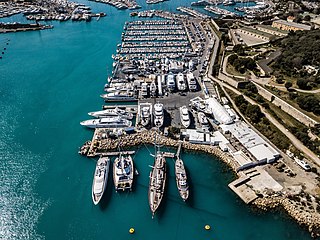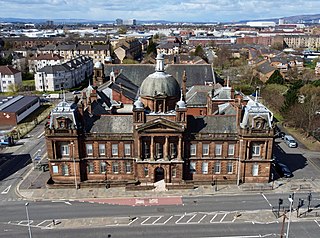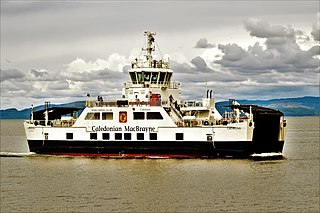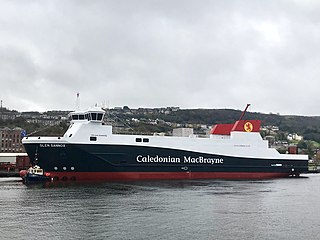
The Firth of Clyde is the mouth of the River Clyde. It is located on the west coast of Scotland and constitutes the deepest coastal waters in the British Isles. The firth is sheltered from the Atlantic Ocean by the Kintyre peninsula, which encloses the outer firth in Argyll and Ayrshire. The Kilbrannan Sound is a large arm of the Firth of Clyde, separating the Kintyre Peninsula from the Isle of Arran. Within the Firth of Clyde is another major island – the Isle of Bute. Given its strategic location at the entrance to the middle and upper Clyde, Bute played a vital naval military role during World War II.

A shipyard, also called a dockyard or boatyard, is a place where ships are built and repaired. These can be yachts, military vessels, cruise liners or other cargo or passenger ships. Compared to shipyards, which are sometimes more involved with original construction, dockyards are sometimes more linked with maintenance and basing activities. The terms are routinely used interchangeably, in part because the evolution of dockyards and shipyards has often caused them to change or merge roles.

Govan is a district, parish, and former burgh now part of south-west City of Glasgow, Scotland. It is situated 2.5 miles (4.0 km) west of Glasgow city centre, on the south bank of the River Clyde, opposite the mouth of the River Kelvin and the district of Partick. Historically it was part of the County of Lanark.

Port Glasgow is the second-largest town in the Inverclyde council area of Scotland. The population according to the 1991 census for Port Glasgow was 19,426 persons and in the 2001 census was 16,617 persons. The most recent census in 2011 states that the population has declined to 15,414. It is located immediately to the east of Greenock and was previously a burgh in the county of Renfrewshire.

John Brown and Company of Clydebank was a Scottish marine engineering and shipbuilding firm. It built many notable and world-famous ships including RMS Lusitania, RMS Aquitania, HMS Hood, HMS Repulse, RMS Queen Mary, RMS Queen Elizabeth and the Queen Elizabeth 2.

Bowling is a village in West Dunbartonshire, Scotland, with a population of 740 (2015).

Ailsa Shipbuilding Company was a Scottish shipbuilding company based in Troon and Ayr, Ayrshire.

William Denny and Brothers Limited, often referred to simply as Denny, was a Scottish shipbuilding company.
Alexander Stephen and Sons Limited, often referred to simply as Alex Stephens or just Stephens, was a Scottish shipbuilding company based in Linthouse, Glasgow, on the River Clyde and, initially, on the east coast of Scotland.

Ferguson Marine Limited is a shipbuilding company whose yard, located in Port Glasgow on the Firth of Clyde in Scotland, was established in 1903. It is the last remaining shipbuilder on the lower Clyde and is currently the only builder of merchant ships on the river. For some years the company's mainstay has been Roll-on/roll-off ferries, primarily for Caledonian MacBrayne (CalMac), including a series of innovative hybrid diesel-electric/battery-powered vessels. Beset with difficulties since 2018 over their latest two CalMac ferries, Fergusons' largest ever vessel, the shipyard was nationalised in December 2019. It is now classified as an executive non-departmental public body of the Scottish Government.

MV Hebrides is a ferry owned by Caledonian Maritime Assets Limited and operated by Caledonian MacBrayne from Uig to Lochmaddy and Tarbert, the main settlements of North Uist and Harris respectively.
MacCrindle Shipbuilding Ltd was a shipbuilder in Ardrossan, Scotland.
Cochrane Shipbuilders was a shipbuilder at Selby.

Caledonian Maritime Assets Limited owns the ferries, ports, harbours and infrastructure for the ferry services serving the west coast of Scotland, the Firth of Clyde and the Northern Isles.

Bay Shipbuilding Company (BSC) is a shipyard and dry dock company in Sturgeon Bay, Door County, Wisconsin. As of 2015, Bay Ships was a subsidiary of Fincantieri Marine Group and produces articulated tug and barges, OPA-90 compliant double hull tank ships and offshore support vessels. It also provides repair services to the lake freighter fleet. In the past the shipyard located in Sturgeon Bay has operated under several different names and traces its history back to 1918.

MV Catriona is a pioneering diesel electric hybrid passenger and vehicle roll-on, roll-off ferry built for Caledonian MacBrayne for the Claonaig–Lochranza crossing. She is the third hybrid ferry commissioned and owned by Caledonian Maritime Assets, one of three such ferries in the world to incorporate a low-carbon hybrid system of diesel electric and lithium ion battery power. The ferries are sea-going and are nearly 46 metres (150 ft) long, accommodating 150 passengers, 23 cars or two HGVs.

MV Glen Sannox is a dual-fuel car and passenger ferry currently under construction at Ferguson Marine in Port Glasgow for Caledonian MacBrayne. Initially expected to enter service in summer 2018 at a cost of £97 million, the ship has been the subject of an ongoing political scandal known as the "ferry fiasco" owing to increased costs and lengthy delays to her construction.

PS Duchess of Fife was a paddle steamer built in 1903 for the Caledonian Steam Packet Company. She spent most of her career serving passenger routes in the Firth of Clyde and was requisitioned for use as a minesweeper during both World Wars. In 1940 she took part in the Dunkirk evacuation, rescuing a total of 1,633 allied troops.














